The problem of unstable voltage in the power grid occurs not only in suburban settlements or remote villages, but also in large cities. Power surges can even damage electrical appliances - especially delicate electronics. A special stabilizer helps to avoid this. What is it, how to choose it and what 6 voltage stabilizers deserve the title of the best, we will now tell you.
CONTENT
- 1 Why do you need a voltage stabilizer and what they are
- 2 What to look for when choosing a voltage regulator
- 3 TOP 6 best voltage stabilizers
- 4 FAQ
Why do you need a voltage stabilizer and what they are
Unstable voltage can cause damage to electrical appliances: due to a sharp jump, thin electronics can simply burn out. To combat this threat, voltage stabilizers are used, the task of which is to equalize the parameters of the current received at the input and produce a stable voltage at the output. Stabilizers cope with this task in different ways, so several types of devices can be found on the market.
Relay. The most common due to the relatively modest price. They are distinguished by a wide range of operating voltages (approximately 105-280 volts) and a high stabilization rate (within 20 milliseconds), but is not able to provide high accuracy of the output voltage: the error of these devices can reach 6-8%. They are perfect for everyday use, but it is better not to connect complex electronics, professional lighting devices or medical equipment to them.
Electromechanical. Unlike relay ones, they are capable of operating with a low error (within 3%), however, stabilization occurs rather slowly and usually does not exceed 10 volts per second, and their input voltage range is rather narrow, in the range of 140-260 volt.
Hybrid (combined). Here, along with the electromechanical base, a relay mechanism also works, therefore the range of input voltage here is much wider than in conventional electromechanical stabilizers and is similar to relay models. Otherwise, in terms of parameters, they repeat the devices from the previous paragraph.
Electrodynamic. This is, in fact, a modification of electromechanical models, in which, by introducing a number of improvements, it was possible to increase the voltage stabilization accuracy up to 0.5% and significantly extend the service life of the devices. True, they cost several times more than their electromechanical counterparts.
Electronic. Perhaps the most expensive stabilizers on the market, however, they also differ in high accuracy (up to 1-2%), instant response and a wide range of input voltages (85-305 volts).
Inverter. The most modern type of voltage regulator using pulse-width modulation. These devices are distinguished by the widest input voltage range, the shortest response time and a small error, which does not exceed 1-2%. The main problem, as usual, is the price.
What to look for when choosing a voltage regulator
Phase. For use in an apartment, in most cases, there is no need to buy a three-phase stabilizer with a voltage of 380 volts, a single-phase 220 volt is quite enough. A three-phase stabilizer is needed if a private house or workshop is powered from a 380 volt network, and three-phase consumers are connected to the stabilizer.
Power. To roughly calculate the power of the voltage stabilizer, it is enough to add up the power consumption of all electrical appliances that will be powered through the stabilizer. But there are three important points here.
Firstly, reactive consumers (devices equipped with electric motors) at the moment of start-up give out peak power, which can be several times higher than the rated power.
Secondly, the actual power of the stabilizer may be lower, and the actual power consumption of the devices may be higher than that stated in the passport. Therefore, it is worth taking a voltage regulator with a power reserve of 20-30%.
Third, the total power consumption, measured in volt-amperes, differs significantly from the active power, measured in watts, since it also includes reactive power. To find the total power consumption, you need to divide the active power by a factor that takes into account the reactive component of the electric current. The exact value of this parameter is usually indicated in the device passport, but for simplicity it is usually taken equal to 0.7.
Stabilization accuracy. This parameter shows how close to the reference 220 volts the voltage at the output of the stabilizer will be. The error should not exceed 8%, and in modern electronic and inverter devices it is close to 0.5-1%.
Stabilization speed. The higher it is, the better. If the stabilizer does not perform its work quickly enough, a voltage surge may have time to spoil the devices.
Noise level. Stabilizers tend to make sounds during operation - this is due, in particular, to switching coils. It is not always possible to install a voltage stabilizer in a residential area.
Operating voltage range. The wider it is, the better, because only with voltage drops within this range, the stabilizer will be able to produce the desired 220 volts, plus or minus an error.
Indication. The most common LED indication of pulses, however, there are also stabilizers equipped with LCD displays, which, in particular, show the voltage at the input and output.
Installation. The stabilizers can be installed on the floor, suspended from the wall or installed in special racks. The choice of a particular type here is a matter of taste and free space.
TOP 6 best voltage stabilizers
Best electronic voltage regulator
1. Energy Classic 5000 (3.5 kW)
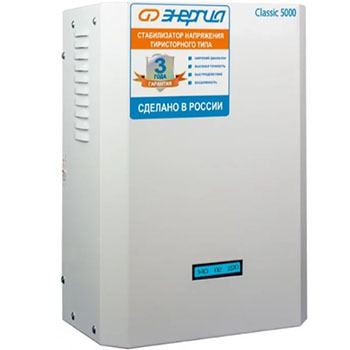
Single-phase electronic thyristor voltage regulator with an active power of 3.50 kW and a total power consumption of 5 kVA. The operating range of input voltages is 125-254 V, but for a short time it can withstand the limit voltage of 60-265 V. The stabilization accuracy is 5%, the output voltage ranges from 209-231 V. The response time is 20 ms. Protection against short circuit, overheating, overvoltage and interference is provided. Wall mounting, digital indication of input and output voltage. It can be used at temperatures up to -40 degrees. The issue price is 23,800 rubles.
Price: ₽ 23 800
Energy Classic 5000
Best inverter voltage regulator
2. Calm IS1500 (1.125 kW)
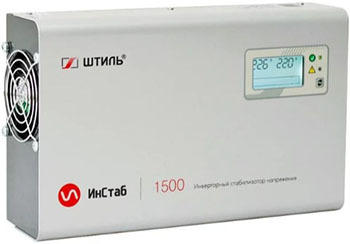
Compact inverter voltage regulator low power (active power - 1.12 kW, total power - 1.5 kVA), which is well suited for working with a small number of consumers. The device is designed to work with a single-phase network and an input operating voltage of 110-290 V (the maximum input voltage is 90-310 V). The modern design provides a low error of less than 2% and almost instantaneous response. There is a digital indication of the input and output voltage, as well as protection against short circuit, overheating, overvoltage and interference. Inexpensive device (about 12,500 rubles) for wall placement.
Price: ₽ 12 470
Calm IS1500
The best electromechanical voltage regulator
3. RESANTA ACH-5000/1-EM (5 kW)
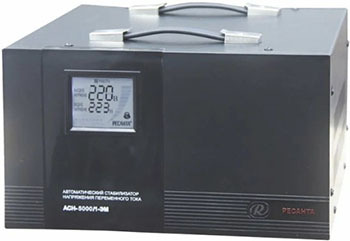
Inexpensive single-phase electromechanical voltage stabilizer with an active power of 5 kW. Like all electromechanical models, it works in a rather narrow range of input operating voltage - from 140 to 260 volts - and does not have a high reaction speed: the response time is approximately 10 volts in give me a sec. However, for its 10,500 rubles, the device provides a very high stabilization accuracy: the error is only 2%. There is protection against short circuit, overheating and overvoltage, as well as digital indication of operation. The device is installed on the floor.
Price: ₽ 10 450
RESANTA ACH-5000/1-EM
Best Relay Voltage Regulator
4. RESANTA ACH-3000/1-C (3 kW)
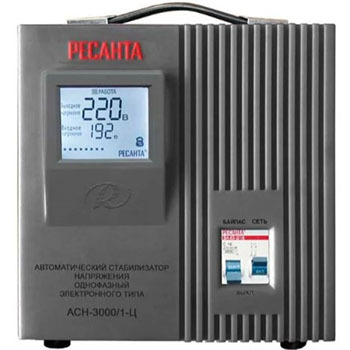
Inexpensive outdoor voltage stabilizer relay type costing only 5,000 rubles. At the same time, the price / power ratio is quite decent: the device is designed for an honest 3 kilowatts of active power. Able to work with voltages in the range from 140 to 260 V in a single-phase network. The stabilization speed is traditionally high for this class of devices - 35 volts per second with a response time of 7 ms, but the alignment accuracy is not very good, the error is about 8%, which gives an output voltage of 202 to 238 V. There is protection against short circuit, overheating, overvoltage and interference, digital indication. An excellent budget model for home use.
Price: ₽ 4 740
RESANTA ACH-3000/1-C
Best Hybrid Voltage Regulator
5. Energy Hybrid 1000 (2019)
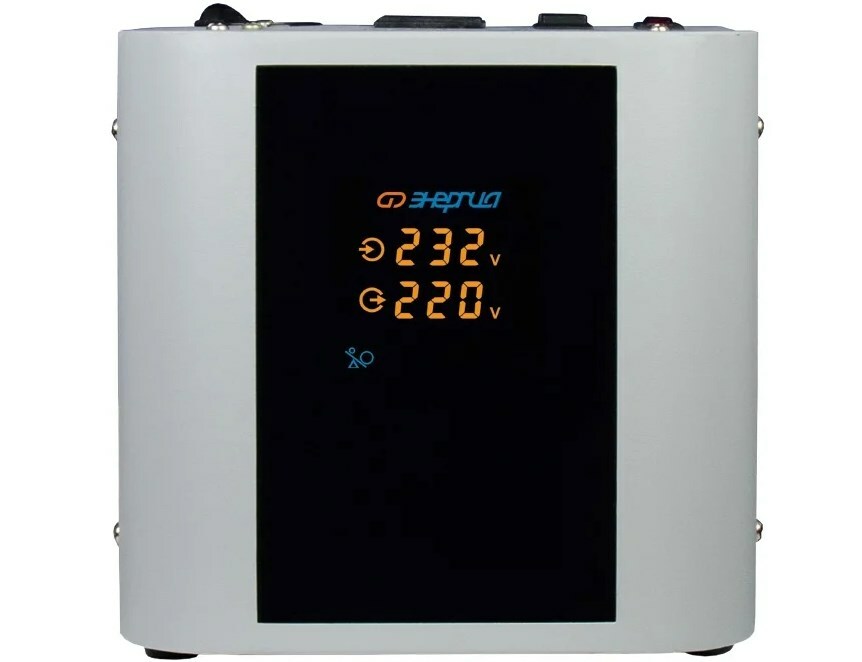
This budget combined voltage regulator costs around 4,200 rubles, but it has good characteristics for its modest price list. The total power of the device is 1 kVA, the operating range of the input voltage is 130-250 V, and the maximum input voltage is 105-275 V. High stabilization accuracy with an error of 3% provides the output voltage in the range from 213 to 227 V. The stabilization speed is quite decent - 20 V / s. Built-in protection against short circuit, overheating, overvoltage and interference. Both floor and wall placement are possible. The devices are connected via 3 sockets.
Price: ₽ 4 300
Energy Hybrid 1000
The best voltage regulator for a gas boiler
6. Huter 400GS (0.35 kW)
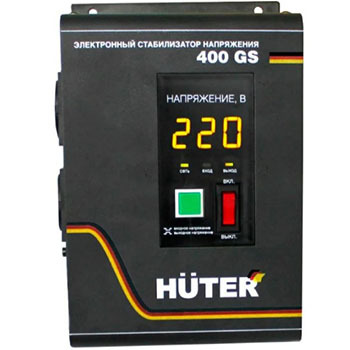
Personal relay-type voltage regulator, which is ideal for working with a gas boiler or other serious consumer. The active power of the device is 350 W at a full power of 400 VA. The device works with a single-phase network, maintaining an input operating voltage in the range of 110-260 V, and output - 202-238 V (stabilization accuracy here is traditionally for all relay stabilizers not exceeds 8%). The response time is 7 ms. In the presence of protection against short circuit, overheating and overvoltage. The stabilizer is placed on the wall and displays information about the input and output voltage in digital form. The price of the device is quite humane - less than 3000 rubles.
Price: ₽ 2 720
Huter 400GS
FAQ
Why does the voltage regulator click?
Most likely, this is the switching of the windings during power surges. That is, if the stabilizer clicks, it just does its job.
What type of stabilizer is most reliable?
It's hard to say: they are all about equally reliable. But in general, as a rule, inexpensive relay stabilizers from China have the lowest service life, and expensive electronic ones have the highest.
